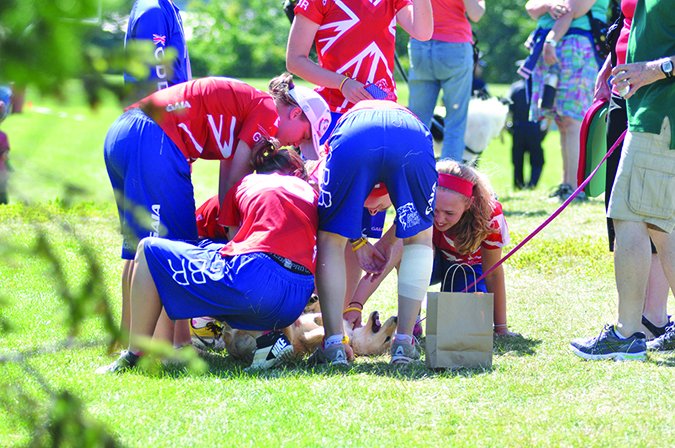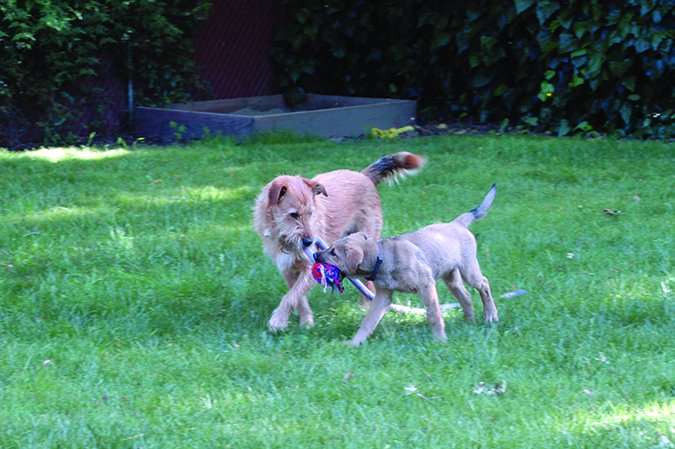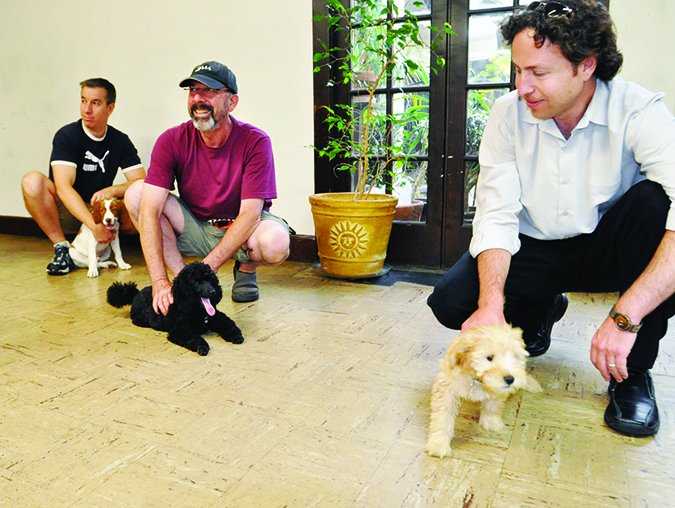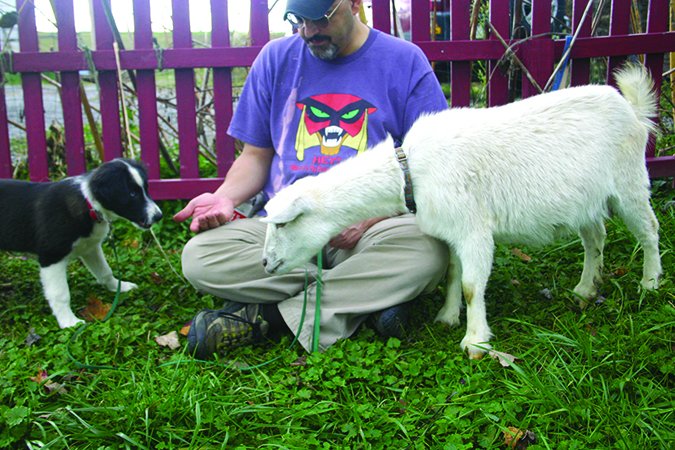PUPPY SOCIALIZATION: OVERVIEW
1. Make a commitment to super-socialize your puppy, and then do it — early. Don’t procrastinate; you don’t have much time!
2. Stay aware of your pup’s body language and help him out of trouble if he looks stressed. Be prepared to take prompt remedial action it your pup has a negative experience during your socialization program.
3. Sign up as soon as possible for a well-run positive puppy class, where both of you can socialize and have a good time.
When it comes to puppies who don’t get lots of opportunities to interact positively with other dogs, new people, or novel situations, the end results are often messy.

While curiosity and the ability to learn don’t have expiration dates, young puppies have an important behavioral “sweet spot” between the ages of 13 and 14 weeks. During this critical period, your dog builds her impressions and attitudes about what is normal and acceptable. At this time more than any other, positive experiences with the world around her build a solid foundation for the rest of your dog’s life.
As recently as 30 years ago, trainers and owners didn’t talk much about puppy socialization. But today, most people know about the importance of making puppies well-rounded little Renaissance hounds. And as they have gotten busy signing up for puppy kindergarten and arranging play dates with the dog next door, a new concern has developed: Fueled more by enthusiasm than knowledge, some people expose puppies to the world in a way that emphasizes its dangers rather than its delights.
Like anything in life, it’s all about balance. Here are some tips to help you guide your puppy through this brave new world in a way that will broaden her horizons and build her confidence.
Keep Your Puppy’s Experiences Positive
Socialization isn’t just about exposing your puppy to new things. It’s also about carefully monitoring these interactions to ensure they are positive ones. Though puppies can seem precociously unflappable – especially when they are gnawing your ankles – they are sensitive souls who can easily become overwhelmed. Your job is to gauge the tenor of a situation by reading your puppy’s body language.
“If your puppy clings to you, if she’s yawning or turning her head away, she’s stressed. Forcing the puppy will just make it worse,” says trainer and author Teoti Anderson of Fort Lauderdale, Florida. “Puppy emotions can be so fleeting. If more puppy owners paid attention to that, and just let the puppy go at his own pace, they’d avoid a lot of problems.”
In the buffet of sensory stimulation that your puppy encounters, make sure his experience is a quick snack rather than a binge. A visit to your child’s soccer game, for instance, can do more harm than good if you are distracted, a pack of kids swarms the cute new puppy, and someone’s snarky Schnoodle meanders over to chomp instead of chat. Less really can be more.
“I like lots of frequent, short sessions. Some puppies shouldn’t go out every day, especially if you have a puppy that’s a little shy,” Anderson says. “Instead, find five friends of different ages and ethnicities and have them over for 10 minutes.” Your puppy will be exposed to a variety of new, interesting people, “and you’ve ended it before it can go badly.”
Be sure to monitor the humans in this equation, too, especially if they are not very dog savvy: Something as simple as holding a puppy incorrectly – letting his legs dangle without supporting his bottom, for instance – can make him feel unstable and unsafe.

Expose Puppies to New People at Home
Speaking of the home front, that’s often one place that’s ignored as people rush out to take their new puppies to Home Depot parking lots and the Petco treat aisles, hoping to imprint them with a zest for the outside world.
“People take their puppies out into the world to socialize them, but they forget to bring other living beings into their home,” says trainer and author Pia Silvani, assistant vice president and behavior specialist at St. Hubert’s Animal Welfare Center in Madison, New Jersey.
This doesn’t just apply to other people and children; be sure to invite some canine guests, too. “Many dogs are just not used to having other dogs coming on their property,” Silvani says. “The risk is that they can become territorial in their own home” because they’ve simply never had the chance to learn how to politely welcome a visitor.
Socializing at Puppy Kindergarten
Puppy kindergarten classes are a great way for puppies as young as eight weeks old to meet other dogs and people, provided it is in a controlled environment. A good class will require your puppy to have at least one vaccine, and will disinfect the classroom space before puppies assemble to cut down on the risk of communicable diseases.
Before plunking down your cash and signing up, visit a session without your puppy. Watch and see how the instructors manage the class. Are they watching out for different breed-specific playing styles? (Pairing a mouthy retriever with a chase-motivated herder might not end well.) Are they intervening and redirecting behavior that might escalate to something unpleasant?
Above all, these classes should not be a no-holds-barred romper room. Even if they don’t know it, when human kindergartners play, they are being taught important social concepts like self-control and respect for others, and it should be the same with their furry counterparts.
“Some people have the misconception that they’re going to bring their puppy into class and it will be an hour of playtime. And they believe if they don’t have that their puppy is not getting socialized,” Silvani says. “But socialization can mean sitting next to another dog in a calm fashion – it doesn’t have to entail wild, frenzied play. That’s a part of it, so they learn to read body language – but it’s a minor part.”
Veterinarian, trainer, and author Sophia Yin, DVM, reminds that avoiding inappropriate friends is just as important for four-leggers, too.
“People just think all play is fine because that’s a dog being a dog,” she says. “But if you had a child, you wouldn’t let him play with a bunch of kids who are swearing and hitting each other. Puppies can learn all kinds of unwanted behaviors” – and start morphing into the canine version of a schoolyard bully.
“For dogs who are having fun, one of the worst things they can learn is to play too roughly and have no impulse control,” Dr. Yin continues. “By letting them play in an ugly way, they get more and more practice being overly aroused. Over-arousal and aggression are on a continuum. If dogs learn to have no self-control and react without thinking, they can become aggressive.”
The lesson that Yin wants puppies to walk (or bounce!) away with is that calming down has tangible benefits. “I want dogs to be able to come when called, focus on me, and the reward is that they can go play again. It teaches the dog that, ‘Hey, it’s not that I can’t have these things. I just have to have a little self-control and be polite about it.'”
Anderson adds that while puppy kindergarten shouldn’t be a mosh pit, it shouldn’t be “a glorified obedience class,” either. “Obedience is the easy part,” she says. “But the time for that puppy foundation is finite.” Baby puppies should be learning more general life skills, she says, like how to accept handling and grooming (including the oft-dreaded nail cutting or grinding), and bite inhibition.
When Puppies Meet Adult Dogs
As their name suggests, puppy kindergarten classes are full of, well, puppies. But trainer and author Trish King of Marin County, California, points out that even more than playing with their peers, youngsters need positive interactions with older dogs who will help them understand and respect boundaries.

“Sometimes it’s really hard to find appropriate adults for puppies to play with,” she says. As a result, “many puppies have trouble learning how to play appropriately, show deference to adults, and back off.”
At all costs, avoid play dates with Cujo wanna-bes, which sounds easier than it actually is. Some people are utterly clueless about their dog’s social graces, or lack thereof. “You have to screen the other dog and be realistic,” Anderson reminds. “If the adult has a history of not liking other dogs, introducing him to a puppy will not miraculously make it better.”
After asking how social the potential playmate is with other dogs, it’s also important to inquire about his play style. “Does he play roughly? Is he mouthy? Is he a chaser?” asks Silvani, adding that breed-specific temperament differences, as well as size differential, are important, too.
Finally, absolutely, positively no dog parks, which can be magnets for undersocialized dogs of all ages and their benign, but dangerously clueless, owners.
What Vets Say About Puppy Socialization
One of the biggest obstacles to proper puppy socialization can come from a seemingly unlikely source: veterinarians.
While no veterinarian wants to see a carefree puppy develop into a growling hermit, his or her primary focus is making sure that your puppy is not being exposed to infectious disease. As a result, many vets insist that their clients not take puppies out into the world until their booster vaccine series is complete and they are fully immunized, which is typically at 16 weeks – two weeks after the vitally important socialization window has closed shut.
Veterinary objections to even a nuanced approach to puppy socialization – arranging play dates with known, healthy dogs, and avoiding well-trafficked areas such as parks – are “huge,” Silvani says. “A lot of times I hear vets in Manhattan saying, ‘Don’t let your puppy hit the ground until he’s six months old'” – leaving legions of urbanites to paper-train large-breed puppies in postage-stamp-sized bathrooms or terraces. In private, she continues, many vets will acknowledge the importance of socialization, but will also voice concerns that they will be liable if something does go wrong.
King understands why many vets are so cautious in this regard, but points out that they could be unwittingly creating a situation that is just as life threatening: “The number-one reason dogs are surrendered to shelters is behavioral problems.” In other words, the odds are greater that a dog might be euthanized for a serious behavioral issue than coming down with parvovirus or kennel cough.
Dr. Yin says many of her veterinary colleagues also don’t realize that the science doesn’t support their concerns. She points to a recent study published this year in the Journal of the American Animal Hospital Association that found puppies who had been vaccinated once and attended socialization classes were at no greater risk of parvovirus infection than vaccinated puppies who did not attend those classes.
Of course, says Dr. Yin, be sure the class follows good sanitary protocols: She knows of one that uses a steam cleaner on its floor several times a week to kill bacteria and other nasties. Requiring that puppies have at least one vaccination and be free from illness are other basic requirements.
Dr. Yin notes the American Veterinary Medical Association is working on a statement on puppy socialization. And the American Veterinary Society of Animal Behavior already has a position statement on the same topic, which concludes that the risk of contagious disease is the lesser of two evils compared to the effects of inadequate socialization.
“During [the first three months of life] puppies should be exposed to as many new people, animals, stimuli and environments as can be achieved safely and without causing overstimulation manifested as excessive fear, withdrawal or avoidance behavior,” the AVSAB paper says. “For this reason, the American Veterinary Society of Animal Behavior believes that it should be the standard of care for puppies to receive such socialization before they are fully vaccinated.”
Despite these welcome changes in attitude about the importance of socializing puppies, you might very well encounter resistance from your veterinarian. In the end, it’s up to you to weigh the pros and cons, sort out your level of comfort, and make the best decision for you and your puppy.
Safe Ways to Socialize Before Full Immunization
Even before your puppy is vaccinated, you can still provide opportunities for him to socialize. Here are some ideas.
– Invite your friends over. Children, adults, men, women, the UPS driver, the gardeners – have your pup see and experience these people in and around your home.
– Take your puppy to a trusted friend’s house. Just going into a new environment will offer your puppy lots of new experiences.
– Invite your friends’ healthy, vaccinated, and puppy-friendly dogs over for a play date. Playing with other dogs is important for puppies’ social development and to learn not to bite hard in play.
– Take your pup on a walk. Just don’t allow him to walk places where there might be feces or urine from other animals.
– Take a large blanket to the park. Let your pup watch the world go by on the safety of the blanket.
– Take your pup for car rides. Help him get used to the motion on short rides to the store or even just around the block.
– Visit businesses that welcome dogs or a sidewalk café. Carry your pup in – or in the case of a cafe, set him up on a mat – and let him take in the sights and smells.
Visit the Vet’s Office
When it comes to your veterinarian, don’t forget to socialize your puppy to that office, and its strange smells and sights, when you have no other reason to go there! Do Happy Vet Visits! “Don’t go there only when your puppy needs his shots,” Anderson advises. “Have the vet techs give him a cookie and leave.”
To make bona-fide visits go smoother, Anderson suggests accustoming your puppy to stand on a mat at home – a rubber-backed bath mat is fine – so you can transfer that surface to the vet’s office. Placing it on the scale or exam table will reduce your puppy’s anxiety, “like Linus with his blanket.”
Expose Your Pup to a Variety of Things
Socialization isn’t just about exposure to new people and places; it’s also about acclimating a puppy to all sorts of experiences: loud noises like hairdryers and fire trucks; things that move oddly, like people on crutches or skates; strange surfaces such as manhole covers, deep sand, and wooden bridges; and all types of weather. Here is a list of just SOME everyday things you’ll want to consider introducing to your puppy: “The Puppy Socialization Exposure Checklist“.
Anderson remembers babysitting a dog who would eliminate only on pine straw, because the only walks she had ever taken were in conifer-covered woods. “I had this huge, fenced-in backyard,” but her canine visitor insisted on pottying right next to the house – the only part of the property that had pine trees near it. Similarly, dogs who are accustomed to doing their business only on grass will be stymied when visiting a city and encountering blocks of pavement and blacktop.
Silvani makes sure to expose her dogs to cats and wildlife, taking puppies outside to watch a nearby herd of deer, and rewarding them for their calm behavior and attentiveness to her. “It creates a positive association with wildlife,” she explains. “This way you don’t have a dog who’s out there chasing chipmunks and squirrels, which can be a real danger.”
Conversely, make sure they are introduced to modern conveniences, especially those that involve movement, such as elevators and automatic doors. If you live in a rural setting, find safe and controlled ways to expose your puppy to traffic and the noise of suburban and urban settings – sirens, horn honks, rattling trucks. If you don’t have easy access to the real thing, invest in a CD of city sounds. And while you’re at it, you might pick up a recording of thunderstorms, another behavioral bugaboo that you can defuse with a positive association, such as feeding your puppy dinner while the recording plays.
Socialization to water can be a literal lifesaver. At five years old, Silvani was walking a dog she rescued when he became dangerously overheated. She remembers trying to walk him into a nearby stream to cool him off, but he refused – no amount of pulling or cajoling would make him reconsider. Silvani learned her lesson those many years ago: Today, she takes all her puppies for riverside romps where they play, get treats, and learn to love the wet stuff.
Never Force a Scared Puppy
Almost inevitably, eventually your puppy will encounter a situation or person that frightens him. The answer is not to force the puppy to “deal with it,” but rather to give him the space to come to terms with his fear on his own.
“If a puppy is running from a tall man wearing a hat, don’t put the puppy in the man’s lap and say, ‘He has to get over it.’ That’s overwhelming,” Anderson says. “But if you put the puppy on the ground, and the puppy chooses to go over and say hello,” that’s a better tactic. (Having the behatted man sit on the floor, with a pocket full of juicy treats, would nudge that encounter in the right direction.)
When a puppy is startled or concerned, some trainers advocate ignoring the fearful behavior and not comforting the puppy, lest you reinforce the reaction.
Knowledgeable behavior professionals know that kind of thinking is misguided – and that it misses the larger point. You can’t reinforce emotions, but you can encourage the pup to enjoy the experience. King says“You want to switch over the brain, so he’s not thinking about how afraid he is, but rather how much fun he’s having.” Like a child who’s skinned his knee, you can go over, console him briefly and make sure he’s okay – then change the subject to something fun so the sniffling stops.
Places NOT to Take Your New Puppy
As important as socialization is, it’s equally important to avoid places where there’s a high risk of endangering your baby dog’s health or safety, or giving him a negative association with his world. Here are just a few of the places where you shouldn’t try to socialize your pup:
1. Off-leash dog parks, until he is fully vaccinated.
2. Any place where he is likely to encounter stray dogs.
3. Any place where he is likely to encounter sick dogs.
4. Any place where he is likely to encounter aggressive dogs.
5. Any place where he is likely to encounter aggressive/rowdy/drunk humans.
6. Places where there is an accumulation of feces from unknown dogs.
7. Any place he is not welcome.
8. Any place where he would have to be left unattended, or in a hot car (no tying
up outside the grocery store!).
9. Any place where he will be uncomfortable or frightened (sitting in the full sun while you watch your son’s Little League game, at a July 4th fireworks display, at a motorcycle rally, etc).
10. Any place where you won’t be able to devote enough attention to him to secure his safety, security and wellbeing.
Keep The Window Of Opportunity Ajar
While three-to-fourteen-week-old puppies are at the prime age for socialization, their ability to soak up new experiences doesn’t shut off like a faucet once they pass that landmark.
“Probably the most critical factor to me is, don’t stop after puppy class,” Silvani says. “Continue on in the first year” – especially into adolescence, when percolating hormones can create new behavioral challenges. “It’s going to benefit the dog for the rest of his life.”
Conversely, King notes that many people believe dogs can be socialized indefinitely, but at some point, it becomes an issue of reprogramming instead of programming, and changing habits is more difficult and time-consuming than preventing or short-circuiting them in the first place.
“The brain continues to grow for a while and then it stops – new connections aren’t made as fast,” she says. “Older dogs don’t learn as fast or take in as much.” By the time a dog is three or so, the odds of teaching him a new world view are not as favorable as they would have been when he was younger.
Just Do It
We’ve arguably never lived in more dog-friendly times, which should make socializing new puppies a snap. But ironically, it’s that very same modern lifestyle – with its competing demands and time-starved schedules – that can derail the best intentions.
“Puppies are so much work, and I think we are creatures of ‘there’s always time later,'” Anderson says. “People come home, and the cute puppy is now peeing and chewing on oh-my-God-my-favorite-shoe, and the kids have soccer this week, and I had to work late, so we’ll do it next week. And the next thing you know, it’s a six-month-old dog.”
It doesn’t take much to shape your new puppy into a worldly and well-adjusted canine citizen. With the right supervision, that unsocialized puppy can walk into a bar, and – after getting a few scratches behind the ear and a handful of Chex Mix from the bartop – saunter right back out, pleased as punch.






